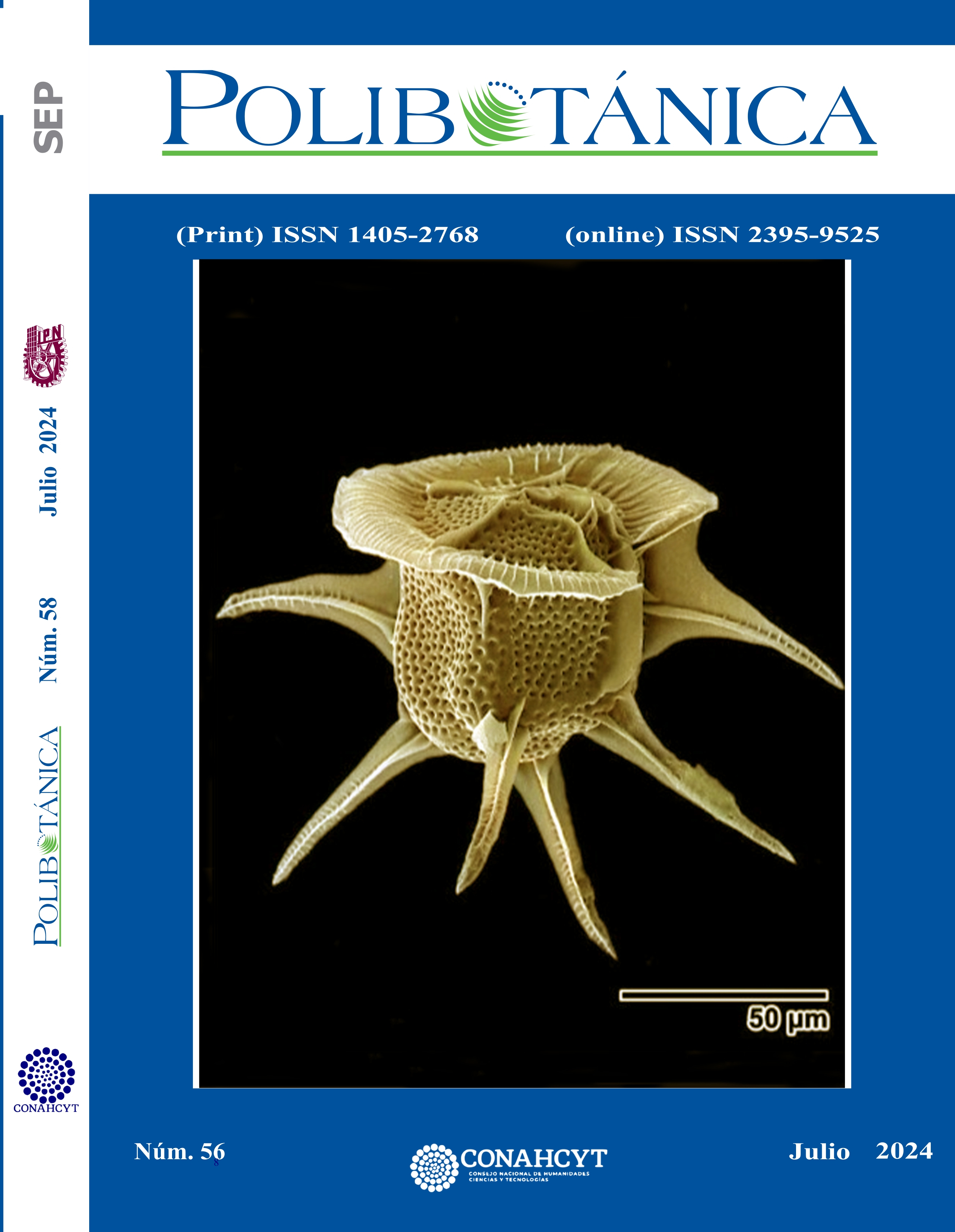First records of dinoflagellates from the Guadalupe Island Biosphere Reserve, Baja California, Mexico
DOI:
https://doi.org/10.18387/polibotanica.58.1Keywords:
Microplankton, Pacific Ocean, Species richness, Natural Protected AreaAbstract
The Guadalupe Island Biosphere Reserve (RBIG) is located 241 km from Mexico's western coast and, thus, is one of the most distant island territories in the country. Therefore, studying its biodiversity is of great interest within the biogeographic context. This study aims to present the first records of three microzooplankton components found at the GIBR: dinoflagellates, radiolarians, and tintinids. We list and illustrate 44 species and infraspecific found taxa, comprising: Dinoflagellata (34), Ciliophora (4), and Radiolaria (6). All dinoflagellate species have been previously recorded in Mexican coastal waters, and two of them, Dinophysis tripos and Phalacroma mitra, have been reported as toxin producers. The present study represents the first contribution to the knowledge of microplankton in the RBIG.
References
Balech, E. 1988. Los dinoflagelados del Atlántico Sudoccidental. Ministerio de Agricultura, Pesca y Alimentación. Publicaciones Especiales - Instituto Español de Oceanografía, 1, Madrid, España. 310 pp.
Benson, R. N. 1966. Recent Radiolaria from the Gulf of California. Ph. D. Thesis, University of Minnesota, pp. 1-577.
Berdegué, A. J. (1957). La Isla Guadalupe México: Contribución al conocimiento de los recursos naturales renovables. Secretaría de Marina, Dirección General de Pesca e Industrias Conexas, México. 67 pp.
Biard, T. & Ohman, M. D. (2020). Vertical niche definition of test-bearing protists (Rhizaria) into the twilight zone revealed by in situ imaging. Limnology and Oceanography, 65: 2583-2602.
Boltovskoy, D. & Riedel, W. R. (1987). Polycystine Radiolaria of the California Current region: seasonal and geographic patterns. Marine Micropaleontology, 12: 65-104;
Gárate-Lizárraga, I. (2008). Nuevos registros de dinoflagelados planctónicos para el Golfo de Tehuantepec, México. CICIMAR Oceánides, 23(1-2): 55-65.
Gárate-Lizárraga, I. & Siqueiros-Beltrones, D. A. (1998). Time variations in phytoplankton assemblages in a subtropical lagoon system after the 1982/83 El Niño event (1984/86). Pacific Science, 52: 79-97.
Gárate-Lizárraga, I., Hernández-Orozco, M. L., Band-Schmidt, C. J., & Serrano-Casillas, G. (2001). Red tides along the coasts of Baja California Sur, Mexico (1984–2001). Oceánides 16, 127–134.
Gárate-Lizárraga, I., Band-Schmidt, C. J., Cervantes-Duarte, R., &. Escobedo-Urías, D. (2002). Mareas rojas de Mesodinium rubrum (Lohmann) Hamburger y Buddenbrock en el Golfo de California (Invierno de 1998). Hidrobiológica, 12(1), 15-20.
Gárate-Lizárraga, I., Okolodkov, Y. B. & Cortés-Altamirano, R. (2016). Microalgas formadoras de florecimientos algales en el Golfo de California. En: García-Mendoza, E., Quijano-Scheggia, S. I., Olivos-Ortiz, A. & Núñez-Vázquez E. J. (Eds.). Florecimientos Algales Nocivos en México. CICESE, Ensenada, México, pp. 130-145.
Gómez, F. (2013). Reinstatement of the dinoflagellate genus Tripos to replace Neoceratium, marine species of Ceratium (Dinophyceae, Alveolata). CICIMAR Oceánides, 28(1): 1-22.
Guiry, M. D. & Guiry, G. M. (2023). AlgaeBase. Worldwide electronic publication, National University of Ireland, Galway. http://www.algaebase.org (consultado el 9 de agosto de 2023).
Hernández-Becerril, D. U., Barón-Campis, S. A., Ceballos-Corona, J. G. A., Alonso-Rodríguez, R., Rincones-Reyes, K. M., Becerra-Reynoso R. T., & Arce-Rocha, G. (2021). Catálogo de fitoplancton del Pacífico central mexicano, Cruceros “MareaR” (2009-2019) B/O “El Puma”. Universidad Nacional Autónoma de México, Ciudad de México, México. 254 pp.
Kling, S. A. & Boltovskoy, D. (1995). Radiolarian vertical distribution patterns across the southern California Current. Deep-Sea Research, 42: 191-231.
López-Fuerte, F. O., Gárate-Lizárraga, I., Siqueiros-Beltrones, D. A., & Yabur, R. (2015a). First record and geographic range extension of the coccolithophore Scyphosphaera apsteinii Lohman, 1902 (Haptophyta: Pontosphaeraceae) from the Pacific coast of Mexico. CheckList, 11(5): 1-3. https://doi.org/10.15560/11.5.1754
López-Fuerte, F. O., Siqueiros-Beltrones, D. A., & Yabur, R. (2015b). First record of benthic diatoms (Bacillariophyceae and Fragilariophyceae) from Isla Guadalupe, Baja California, Mexico. Revista Mexicana de Biodiversidad, 86: 281-292.
López-Fuerte, F. O., Siqueiros-Beltrones, D. A., & Yabur, R. (2021). Primeros registros de diatomeas marinas de la Clase Coscinodiscophyceae de la Reserva de la biosfera Isla Guadalupe, Baja California, México. Cymbella, 7(1): 5-17. http://cymbella.mx
Lundholm, N., Churro, C., Escalera, L., Fraga, S., Hoppenrath, M., Iwataki, M., Larsen, J. Mertens, K., Moestrup, Ø., Tillmann, U., Zingone, A. (eds.) (2009 onwards). IOC-UNESCO Taxonomic Reference List of Harmful Micro Algae. Accessed at https://www.marinespecies.org/hab on 2023-09-26. doi:10.14284/362
Llopis Monferrer, N., Boltovskoy, D., Méndez, M., Sandin, M., Tréguer, P., Not, F., & Leynaert, A. (2020). Estimating biogenic silica production of Polycystina and Phaeodaria (Rhizaria) in the global ocean. Global Biogeochemical Cycles, 34: e2019GB006286.
Lynn, R. J., & Simpson J. J. (1987). The California Current system: The seasonal variability of its physical characteristics. Journal of Geophysical Research, 92: 12947-12966.
Mayén-Estrada, R., Reyes-Santos, M. & Aguilar-Aguilar, R. (2014). Biodiversidad de Ciliophora en México. Revista Mexicana de Biodiversidad, Supl. 85: S34-S43, 2014. doi:10.7550/rmb.31993.
Molina-Cruz, A. (1982). Radiolarians in the Gulf of California: Deep Sea Drilling Project Leg 64. Initial Reports of the Deep Sea Drilling Project, 64(2): 983-1002.
Okolodkov, Y. B. (2010). Biogeografía marina. Campeche, Campeche, Universidad Autónoma de Campeche, México. 217 pp.
Okolodkov, Y. B. & Gárate-Lizárraga I. (2006). An annotated checklist of dinoflagellates (Dinophyceae) from the Mexican Pacific. Acta Botanica Mexicana, 74(1): 1-154.
Omura, T., Iwataki, M., Borja, V. M., Takayama, H., & Fukuyo, Y. (2012). Marine phytoplankton of the Western Pacific. Tokyo, Japan: Kouseisha Kouseikaku. 160 pp.
Quiñones-Peyro, B. C., López-Fuerte, F. O., Mazariegos Villareal, A., Serviere-Zaragoza, E., Casas-Valdez M., & Yabur-Pacheco, R. (2016). Macroalgas marinas bentónicas de Isla Guadalupe, Baja California, México. Hidrobiológica, 26(2): 213-223.
Reguera, B., Riobó, P., Rodríguez, F., Diaz, P. A., Pizarro, G., Paz, B., Franco, J. M. & Blanco. J. (2014). Dinophysis toxins: Causative organisms, distribution and fate in shellfish. Marine Drugs, 12(1): 394-461.
Schiller, J. (1933). Dinoflagellate (Peridineae). Teil 1. Akademische Verlagsgesellschaft M.B.H., Leipzig. 617 pp.
Schiller, J. (1937). Dinoflagellate (Peridineae). Teil 2. Akademische Verlagsgesellschaft M.B.H., Leipzig. 590 pp.
Simon, N., Cras, A. L., Foulon, E., & Lemée, R. (2009). Diversity and evolution of marine phytoplankton. Comptes Rendus. Biologies, 332: 159-170.
Siqueiros-Beltrones, D. A., Martínez, Y. J., & Aldana-Moreno, A. (2019). Florística exploratoria de diatomeas epifitas en Rhodophyta de Islas Revillagigedo. Cymbella, 5: 98-123.
Sournia, A., Chrétiennot-Dinet, M. -J., & Ricard, M. (1991). Marine phytoplankton: how many species in the world ocean? Journal of Plankton Research, 13(5): 1093-1099.
Sournia, A. (1995). Red tide and toxic marine phytoplankton of the world ocean: an inquiry into diversity. In: P. Lassus, G. Arzul, E. Erand, P. Gentien & C. Marcaillou (eds.). Harmful Marine Algal Blooms. Lavoisier, Intercept Ltd. Pp. 103-112.
Steidinger, K. A., & Tangen, K. (1997). Dinoflagellates. En: C.R. Tomas (ed.) Identifying Marine Phytoplankton. Academic Press, San Diego, USA. Pp. 387-584.
Taylor, F. J. R. (1976). Dinoflagellates from the International Indian Ocean Expedition: A report on material collected by the R.V. 'Anton Bruun' 1963-1964. Stuttgart, Germany: E. Schweizerbat'sche Verlagsbuchhandlung. 234 pp., 46 pl.
Tett, P., & Barton, E. D. (1995). Why are there about 5000 species of phytoplankton in the sea? Journal of Plankton Research, 17: 1693-1704.
Torres-Ariño, A., Okolodkov, Y.B. Herrera-Herrera, N.V. Hernández-Barrera, B.L., González-Reséndiz, L., León-Tejera, H., & Gárate-Lizárraga, I. (2019). Un listado del fitoplancton y microfitobentos del sureste del Pacífico mexicano. Cymbella, 5(1): 1-97. http://cymbella.mx
Uribe, E., & Castillo, J. (1980). Tintínidos indicadores de masas de agua. Investigaciones Marinas, 10: 15-34.
Vergara, S. O., Marchant, M., & Giglio, S. (2008). Radiolarios Polycystina (Protozoa: Nassellaria y Spumellaria) sedimentados en la zona centro-sur de Chile (36°-43°S). Gayana, 72(1): 79-93.
Weinheimer, A., & Cayan D. (1997). Radiolarian assemblages from Santa Barbara Basin sediments: Recent interdecadal variability. Paleoceanography, 12(5), 658-670).
WoRMS Editorial Board. (2023). World Register of Marine Species. Available from http://www.marinespecies.org at VLIZ (consultado el 9 de agosto de 2023).
Downloads
Published
Issue
Section
License

Polibotánica by Departamento de Botánica de la Escuela Nacional de Ciencias Biológicas del Instituto Politécnico Nacional se distribuye bajo una Licencia Creative Commons Atribución-NoComercial-CompartirIgual 4.0 Internacional.




















